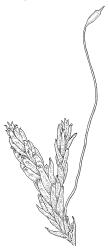The core genus of this small family, Sauloma, was traditionally (Brotherus 1925) placed in a broadly defined Hookeriaceae, a group which has received a great deal of systematic attention and modification in recent years. The Saulomataceae were initially described by Buck et al. (2005) using both molecular data derived from four DNA regions and morphological data. The molecular data they present provides convincing support for the recognition of an evolutionary clade containing Sauloma and the monotypic Chilean genus Ancistrodes Hampe as the sister group to a larger clade corresponding to the Daltoniaceae, Pilotrichaceae, Schimperobryaceae, and a highly reduced Hookeriaceae, collectively. The Saulomataceae were retained by Goffinet et al. (2009) to accommodate Sauloma, Ancistrodes, and another Chilean monotypic genus, Vesiculariopsis Broth.
Because of the considerable morphological differences between Sauloma, Ancistrodes, and Vesiculariopsis, as well as limited or nil available specimens for the last two genera, no family description is presented here. A family description is provided by Buck et al. (2005) for interested users; brief notes on Ancistrodes and Vesiculariopsis are provided here for context.
The nomenclatural type of Ancistrodes is Hookeria ancistrodes Mont. (a heterotypic synonym of Duseniella genuflexa Müll.Hal.). The typification and confusing nomenclature of this genus were clarified by Crosby (1976) and the accepted name of its one species is Ancistrodes genuflexa (Müll.Hal.) Crosby; the genus is described and illustrated as Duseniella genuflexa in the Meteoriaceae by Brotherus (1925, fig. 553). Morphologically Ancistrodes is sufficiently distinct from Sauloma to make its placement in a single family questionable, and it is retained in the Meteoriaceae in some recent online classifications such as the Catalogue of Life (accessed 6 Oct. 2016), and in TROPICOS (accessed 2 Feb. 2017). Material collected by Dusén (CHR 641703) has unbordered leaves abruptly tapered from an oblong base to a long acumen that is crooked apically and bears reflexed, hook-like teeth. The upper laminal cells are firm-walled, ellipsoid, rounded apically, and non-porose (in sharp contrast to those of Sauloma tenella), and weak double costae are present. The stems here are more branched than in S. tenella, and the plant apparently grew pendent from tree trunks. The exothecial cells are firm-walled, mostly quadrate to oblong and weakly collenchymatous. The peristome appears to be accurately portrayed by Brotherus (fig. 553, as Duseniella genuflexa) and the calyptra is mitrate.
No material of Vesiculariopsis spirifolium (Dusén) Broth. has been available for study. Brotherus (1925, fig. 624) illustrated this species (as V. spiripes (Dusén) Broth.) in his treatment of the Leucomiaceae. The illustration shows unbordered ovate-lanceolate leaves borne on much-branched shoots. Vesiculariopsis is not included in the analyses presented by Buck et al. (2005), and their reasons for placing it in the Saulomataceae are not provided.
| Category | Number |
|---|---|
| Indigenous (Non-endemic) | 1 |
| Total | 1 |




